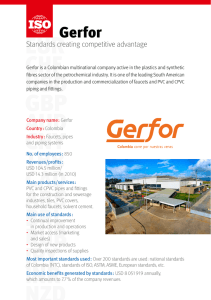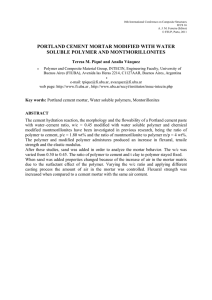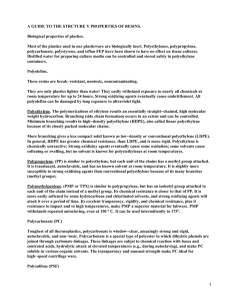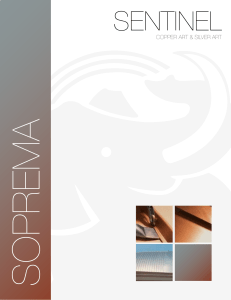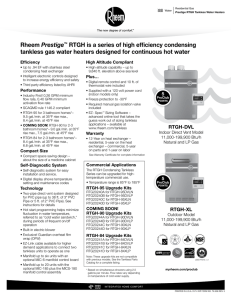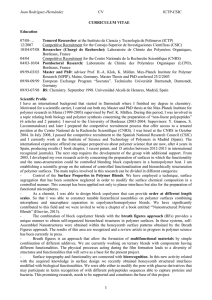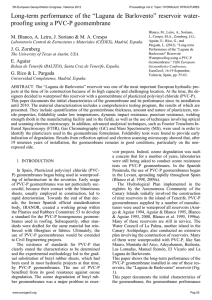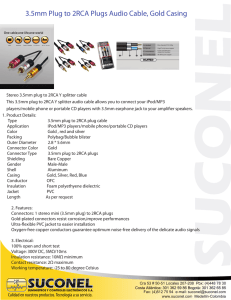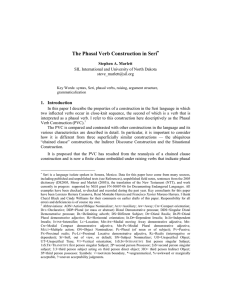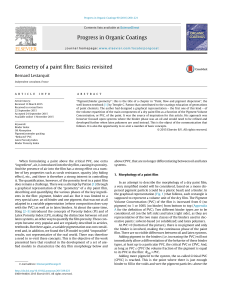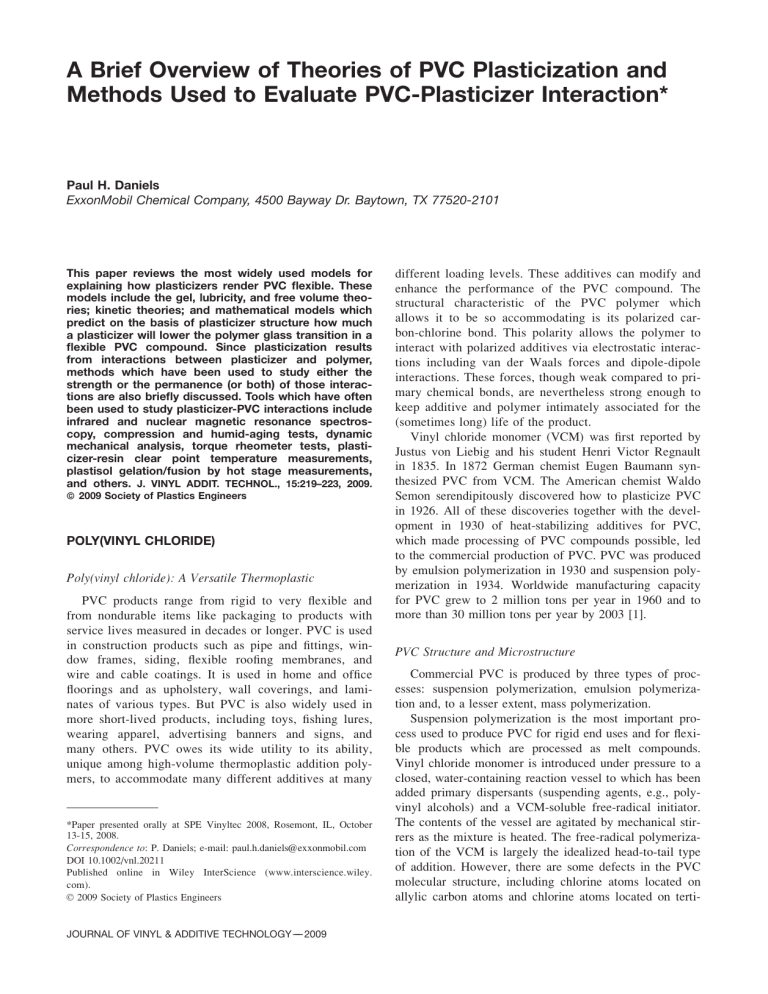
A Brief Overview of Theories of PVC Plasticization and Methods Used to Evaluate PVC-Plasticizer Interaction* Paul H. Daniels ExxonMobil Chemical Company, 4500 Bayway Dr. Baytown, TX 77520-2101 This paper reviews the most widely used models for explaining how plasticizers render PVC flexible. These models include the gel, lubricity, and free volume theories; kinetic theories; and mathematical models which predict on the basis of plasticizer structure how much a plasticizer will lower the polymer glass transition in a flexible PVC compound. Since plasticization results from interactions between plasticizer and polymer, methods which have been used to study either the strength or the permanence (or both) of those interactions are also briefly discussed. Tools which have often been used to study plasticizer-PVC interactions include infrared and nuclear magnetic resonance spectroscopy, compression and humid-aging tests, dynamic mechanical analysis, torque rheometer tests, plasticizer-resin clear point temperature measurements, plastisol gelation/fusion by hot stage measurements, and others. J. VINYL ADDIT. TECHNOL., 15:219–223, 2009. ª 2009 Society of Plastics Engineers POLY(VINYL CHLORIDE) Poly(vinyl chloride): A Versatile Thermoplastic PVC products range from rigid to very flexible and from nondurable items like packaging to products with service lives measured in decades or longer. PVC is used in construction products such as pipe and fittings, window frames, siding, flexible roofing membranes, and wire and cable coatings. It is used in home and office floorings and as upholstery, wall coverings, and laminates of various types. But PVC is also widely used in more short-lived products, including toys, fishing lures, wearing apparel, advertising banners and signs, and many others. PVC owes its wide utility to its ability, unique among high-volume thermoplastic addition polymers, to accommodate many different additives at many *Paper presented orally at SPE Vinyltec 2008, Rosemont, IL, October 13-15, 2008. Correspondence to: P. Daniels; e-mail: [email protected] DOI 10.1002/vnl.20211 Published online in Wiley InterScience (www.interscience.wiley. com). Ó 2009 Society of Plastics Engineers JOURNAL OF VINYL & ADDITIVE TECHNOLOGY— —2009 different loading levels. These additives can modify and enhance the performance of the PVC compound. The structural characteristic of the PVC polymer which allows it to be so accommodating is its polarized carbon-chlorine bond. This polarity allows the polymer to interact with polarized additives via electrostatic interactions including van der Waals forces and dipole-dipole interactions. These forces, though weak compared to primary chemical bonds, are nevertheless strong enough to keep additive and polymer intimately associated for the (sometimes long) life of the product. Vinyl chloride monomer (VCM) was first reported by Justus von Liebig and his student Henri Victor Regnault in 1835. In 1872 German chemist Eugen Baumann synthesized PVC from VCM. The American chemist Waldo Semon serendipitously discovered how to plasticize PVC in 1926. All of these discoveries together with the development in 1930 of heat-stabilizing additives for PVC, which made processing of PVC compounds possible, led to the commercial production of PVC. PVC was produced by emulsion polymerization in 1930 and suspension polymerization in 1934. Worldwide manufacturing capacity for PVC grew to 2 million tons per year in 1960 and to more than 30 million tons per year by 2003 [1]. PVC Structure and Microstructure Commercial PVC is produced by three types of processes: suspension polymerization, emulsion polymerization and, to a lesser extent, mass polymerization. Suspension polymerization is the most important process used to produce PVC for rigid end uses and for flexible products which are processed as melt compounds. Vinyl chloride monomer is introduced under pressure to a closed, water-containing reaction vessel to which has been added primary dispersants (suspending agents, e.g., polyvinyl alcohols) and a VCM-soluble free-radical initiator. The contents of the vessel are agitated by mechanical stirrers as the mixture is heated. The free-radical polymerization of the VCM is largely the idealized head-to-tail type of addition. However, there are some defects in the PVC molecular structure, including chlorine atoms located on allylic carbon atoms and chlorine atoms located on terti- ary carbon atoms. (Both of these types of structures negatively impact the heat stability of the polymer.) The finished resin particles are porous, irregularly shaped (‘‘popcorn shaped’’), and have an average diameter of about 140 microns. Resin particles consist of clusters of primary particles roughly one micron in diameter surrounded by a thin (0.5 to 5 micron) pericellular membrane. The polymer may have a number-average molecular weight ranging from 30,000 (low-medium-MW PVC) to 60,000 (high-MW PVC) up to 150,000 atomic mass units or higher (ultra-high-MW PVC). (Note that the molecular weight of the polymer is commonly indicated by its K value, its intrinsic viscosity in some solvent.) Within the primary resin particles, the polymer exists largely in amorphous form. Short, random, mostly syndiotactic sequences in the repeating units in the polymer allow it to form some crystal structures which are quite important to the performance of the polymer. Roughly 8% of the PVC consists of crystallites, and the average spacing between these crystallites (as determined by x-ray diffraction) is 0.01 microns [2, 3, 4]. Emulsion PVC is used primarily in ‘‘pastes’’ or plastisols which are dispersions of PVC resin in plasticizer. The process used to make these resins is similar to that used to make PVC suspension resins. Vinyl chloride monomer is again introduced to a closed, water-containing pressurized vessel. Likewise, a VCM-soluble free-radical precursor is used to initiate the polymerization reaction. However, in the emulsion resin process, soaps (e.g., sodium lauryl sulfate) are used instead of dispersants. When the reaction vessel and its contents are stirred, an emulsion forms, and VCM is sequestered within the micelles formed by the soap molecules. When the monomer polymerizes, the PVC resin particles assume the dimensions of the interior of these micelles, roughly one micron in diameter and spherical. Differences between emulsion and plastisol resins may be only in the structure, or gross morphology, of the resin particles. The microstructure (polymer MW, crystallinity, number of chain defects, etc.) of resins made by either of these processes can be virtually the same. The structural differences in the resin particles, however, lead to markedly different processability characteristics of the PVC compounds made with each of them. Mixing PVC suspension resins with a quantity of plasticizer equal to as much as one hundred percent (or more) of the mass of the resin under controlled conditions produces a dry-blended PVC compound in which plasticizer has penetrated the amorphous part of the PVC resin and solvated it. Dry-blended PVC compounds are free-flowing powders. Mixing emulsion resins, also under carefully controlled conditions, with similar quantities of plasticizer produces a dispersion of resin particles in plasticizer, a plastisol[2]. PVC plastisols are liquids, viscosities of which vary with the types and levels of plasticizers used and with the types and levels of other viscosity-modifying additives. 220 JOURNAL OF VINYL & ADDITIVE TECHNOLOGY— —2009 Mass-polymerized PVC resins are similar in particle size, porosity, and microstructure to the suspension resins and are used in many of the same end uses. The difference between the suspension resin process and the mass resin process is that the latter does not use water as a reaction medium. Since the PVC polymer is insoluble in liquid VCM, VCM is used instead. The reactor used in the mass polymerization process has two stages. In the first stage, PVC resin seed particles are formed by a freeradical polymerization process under agitation conditions similar to those used in the suspension reactors. When the polymerization reaches about 12% conversion, the reaction mixture is transferred to a second vessel which contains a low-speed mixer more suitable for mixing solids. Unlike the suspension resin particles, mass-polymerized PVC resin particles do not contain any residual dispersant, nor do they have a pericellular membrane. In theory, these differences make mass resins both cleaner and easier to dry-blend with plasticizers. There are, however, a number of practical difficulties with the mass process which have limited its use. The process produces a great number of fine particles which are difficult to separate from the rest. Also, it is more difficult to strip residual VCM from mass resins than from suspension resins, and since PVC is a good thermal insulator, it is difficult to get heat into the second stage of the reaction vessel [2]. PLASTICIZERS Plasticizers are used to make PVC (and other materials) flexible. Internally plasticized PVC consists of VCM which has been copolymerized with another monomer (e.g., vinyl acetate or ethyl acrylate). The resulting copolymer is softer and has a lower modulus and a lower tensile strength than the corresponding PVC homopolymer. Externally plasticized PVC consists of PVC homopolymer in which the amorphous part of the polymer has been solvated by additives, typically esters. The Council of the International Union of Pure and Applied Chemistry defined a plasticizer as a substance or material incorporated in a material (usually a plastic or elastomer) to increase its flexibility, workability, or distensibility. (By this definition) A plasticizer may reduce the melt viscosity, lower the temperature of a secondorder transition, or lower the elastic modulus of the product. Mechanisms of Plasticization Semon discovered external plasticizers for PVC when he was seeking to increase the adhesion of the polymer to metal by dehydrohalogenating it in high-boiling solvents. Some of these solvents turned out to be plasticizers. How external plasticizers effect their changes in PVC has been a matter of conjecture and a subject of research since the 1940s. Early researchers had the advantage of being able to refer to studies of plasticized non-PVC polymers and DOI 10.1002/vnl vulcanized rubber dating back to the mid-1800s. By 1950, two theories for the mechanism of plasticizer function in PVC had been developed, the lubricity theory and the gel theory. The lubricity theory was developed by Kilpatrick [5], Clark [6], and Houwink[7], among others [8]. It holds that plasticizer in PVC acts as a molecular lubricant allowing the polymer chains to move freely over one another when a force is applied to the plasticized polymer. It assumes that the unplasticized polymer chains do not move freely because of surface irregularities. In this model, one segment of the plasticizer is strongly attracted to the polymer, while other segments are not. The former acts as a solvent for the polymer, while the latter acts as a lubricant. The gel theory of plasticization was developed by Aiken and others [8, 9]. It holds that the polymer molecules are loosely tied together at varying intervals. Added plasticizer increases the random motion of the polymer chains in the nonassociated regions of the polymer. Aiken thought that the gel structure could be formed either by permanent intermolecular ties or by ties which form and disappear in dynamic fashion as plasticizer solvates then desolvates these areas. This theory explained why externally plasticized PVC compounds soften more with increasing temperature than do internally plasticized compounds. The external plasticizers are free to solvate and desolvate different sites on the polymer molecule to which they are attracted and to which other polymer molecules might be attracted. Internally plasticized systems lack this freedom. Likewise, the gel theory explains how nonsolvents for the PVC molecule (e.g., some secondary plasticizers) can soften it. They increase the space between polymer molecules, thereby reducing polymer-polymer interactions at sites where polymer chains could associate. The free volume theory of plasticization sought to explain the reduction in polymer glass transition temperature upon the addition of plasticizer. It had been observed that the specific volume of polymers decreased linearly with decreasing temperatures until the Tg was reached. After that, the specific volume decreased more slowly. It was assumed that the increased specific volume above the glass transition temperature was attributable to ‘‘free volume’’, space between molecules. Today, free volume is typically defined as the difference in specific volume at some temperature of interest and some reference temperature, usually absolute zero. (It is difficult to determine what the volume of a plastic would be at absolute zero, so that figure is an approximation.) Free volume in the polymer could come from several sources, motion of polymer end groups, motion of polymer side groups, and internal polymer motions. Below their glass transition temperature, polymers show limited motions of these types. That is why unplasticized PVC is hard and rigid. When plasticizer is added to the polymer, motions in the plasticizer molecule, like motions in the polymer, create free volume [8, 10]. DOI 10.1002/vnl Kinetic or mechanistic theories of plasticization see the association between polymer and plasticizer and between plasticizer and plasticizer as transient and ever-changing. Associations form, disappear, then reform. Some plasticizers form stronger associations with the PVC polymer than others. At low plasticizer loadings in the PVC, plasticizer-polymer associations predominate. At high plasticizer levels, plasticizer-plasticizer associations predominate [8]. Mathematical models for plasticization, such as those developed by Mauritz and Storey [11], attempt to predict the Tg of a plasticized PVC from the glass transition temperatures of the polymer and the plasticizer. The plasticizer efficiency at reducing this glass transition temperature is based on structural features of the plasticizer such as the length and branchiness of the side chains. PVC-Plasticizer Interaction. All of the models of PVC plasticization imply some chemical interaction between the plasticizer and the polymer. Plasticizers must be attracted to the polymers that they modify nearly as strongly as they are to other plasticizer molecules. Without this sort of plasticizer-polymer interaction, plasticizers in plasticized PVC would tend to self-associate, form increasingly larger micropools within the PVC, and eventually exude. Fortunately, every repeating unit in the PVC polymer chain contains a polarized carbon-chlorine bond. This structural feature makes it possible for the polar parts of a plasticizer molecule (e.g., the aromatic ring and the ester linkages in a phthalate ester) to interact with the polymer via van der Waals forces and dipole-dipole interactions. In plasticized PVC these interactions permit the plasticizer in a finished flexible product to solvate the amorphous part of the polymer but not the tightly self-associated crystalline part of the polymer. These crystalline crosslinks between polymer molecules serve a purpose in flexible PVC similar to that of the crosslinks in elastomers or the crosslinks in thermoplastic olefins. They increase the elastic modulus of the polymer, thus giving the strained form some memory for its original shape. Plasticizer-PVC interaction in flexible PVC begins with the mixing step, which proceeds in predictable stages [8]. Upon mixing a dry compound (plasticizer with suspension- or mass-polymerized PVC), the plasticizer first wets the resin particles and then, with externally added heat (either heat generated by the friction of intense mixing or heat from some sort of heating jacket on the mixer), diffuses into and solvates the amorphous part of the PVC polymer. The heat provided is usually sufficient to raise the temperature of the PVC resin to its Tg (approximately 808C). at which point it dry-blends much more rapidly but insufficiently to raise its temperature much beyond 1108C. At that point the PVC resin particles can begin to sinter. Incompletely dry-blended PVC (in which some of the plasticizer is poorly dispersed and some plasticizer is self-associated, not solvating the amorphous part of the JOURNAL OF VINYL & ADDITIVE TECHNOLOGY— —2009 221 polymer) typically produces finished products in which there are regions of high concentrations of plasticizer. This situation eventually leads to exudation. In mixing a plastisol, the plasticizer again wets the resin particles, but in this case, temperatures are maintained well below the Tg of the resin, and the plasticizer does not diffuse into the resin. Mixing can be either highintensity for low-viscosity plastisols or low-intensity for high-viscosity plastisols. The resulting mixture is a dispersion of solid resin particles in plasticizer. These plastisols can be quite stable. Plastisol inks for textile printing, for instance, are often maintained in inventory for several months. Poorly dispersed plastisols contain agglomerated resin particles and have viscosities higher than expected. This condition can make further processing of incompletely mixed plastisols difficult. Like the finished products produced from incompletely dry-blended PVC solids, finished products made from inadequately mixed plastisols can also show regions of high plasticizer concentrations which will eventually lead to exudation. When plastisols are processed, the next step in plasticization is similar to the second step in dry-blending suspension resins; with added heat (up to, say 1108C), plasticizer diffuses into and solvates the amorphous part of the PVC polymer. This solvation swells the resin particles to the point at which all of the liquid plasticizer has been absorbed. At this point the plastisol is said to be gelled. The next stages of PVC plasticization are the same for plastisols and dry compounds. With added heat, plasticizers (partially) dissolve the crystalline parts of the polymer. Depending on the solvating strength of the plasticizer, temperatures of 150-1808C are typically required. At this point the plasticized PVC is in a melt stage where it can be formed to a desired shape. Boundaries between what were originally separate resin particles have been largely obliterated. Note that the PVC is typically not completely melted. Plasticized PVC suspension resin, for example, flows through the final zone of an extruder in primary particles about one micron in diameter. These particles contain bundles of about 10 million PVC polymer molecules. With cooling, the structure of the polymer is reestablished. Crystalline crosslinks reform, rapidly at first and continuing for up to 48 hours, so that crystalline crosslinks are present in the finished product to approximately the same degree as they were in the PVC resin [2, 8]. PREDICTING AND MEASURING PVC-PLASTICIZER INTERACTIONS Plasticizers may be either primary or secondary types. Primary plasticizers are the additives largely responsible for making PVC flexible and are materials which can function without ancillary additives. The main functions of primary plasticizers have already been described. Secondary plasticizers by themselves are not completely compatible with the polymer but are made compatible by 222 JOURNAL OF VINYL & ADDITIVE TECHNOLOGY— —2009 the presence of the primary plasticizer. Secondary plasticizers are used to reduce compound costs or to improve compound properties such as low-temperature flexibility, flame retardancy, or processability. Examples include aliphatic, cycloaliphatic, and partially aromatic hydrocarbon oils and chlorinated paraffins. Several methods have been used to predict the strength of the interactions with PVC of either primary or secondary plasticizers. Among these are several interaction parameters. The Hildebrand solubility parameter is described as the square root of the cohesive energy density, the energy which holds molecules of a substance together [12]. It can be estimated by dividing the heat of vaporization of a substance by its molar volume or, more commonly, by using additive constants for the functional groups in organic molecules. Solubility parameters have proven useful for comparing compatibilities of plasticizers within a homologous series (e.g., phthalates) but are less useful in comparing PVC-plasticizer interactions of plasticizers from different chemical families [8, 12]. Polarity parameters for plasticizers are determined by ratioing the number of apolar carbon atoms in the plasticizer to the number of polar groups present and multiplying this number by the molar mass of the plasticizer [8, 13]. Flory-Huggins interaction parameters have been used for plasticizers with PVC. This mathematical approach uses an interaction factor, chi (v), along with numbers of moles and molar volumes of plasticizer and PVC to predict the energetics of plasticizer-polymer mixing (free energy of mixing) [8, 14]. Experimental methods have also been used to assess the strength of the plasticizer-PVC interactions. FTIR methods typically look at the spectral shift of the plasticizer carbonyl group (assuming that the plasticizer is an ester) and the PVC resin carbon-chlorine bond. The carbonyl and carbon-chlorine bond group absorption frequencies can each be shifted to frequencies several wavenumbers lower (lower energy) when the ester group interacts with the PVC [8, 15–17]. The intermolecular interaction between the polar parts (carbonyl group) of the plasticizer and the PVC (carbon-chlorine bond) slightly weakens the intramolecular bonding forces in the interacting functional groups. Solid state C-13 NMR cross-polarization magicangle spinning (CPMAS) has also been used to study PVC-plasticizer interactions. Chemical shifts and line resolutions as well as spin-lattice and spin-spin relaxation times for the plasticizer carbonyl carbon and alkyl carbons are measured as it interacts with the polymer [8, 18– 20]. The strongest polymer-PVC interactions appear to be between the electronegative region of the plasticizer (carbonyl linkage) and the electropositive atoms of the PVC. Interactions appear to be electrostatic in nature, and polymer flexibility results from free volume created within the polymer as the result of thermal motion of plasticizer alkyl side chains [21]. Nonspectroscopic experimental methods for studying plasticizer-PVC interactions include torque rheometer tests [22] (ASTM D 2396, D 2538), a test for plasticizer DOI 10.1002/vnl compatibility under humid conditions (ASTM D 2383), dynamic mechanical analysis [23], and plasticizer-PVC resin clear point and hot bench gelation tests. Each of these tests indicates how strongly plasticizer and PVC interact by determining the temperature at which the resin dry blends or gels or fuses, or the conditions under which the plasticizer becomes incompatible with the polymer, Over the past eight decades, perhaps 20,000 compounds have been screened as PVC plasticizers. There are presently around 300 plasticizers which are manufactured and perhaps 100 which are of commercial importance. Of these commercially important primary plasticizers, nearly all are esters. Moreover, just three of these esters, di-2ethylhexylphthalate (DOP), diisononylphthalate (DINP) and diisodecylphthalate (DIDP) account for 75% of the PVC plasticizers used in the world today [8, 24]. Plasticizers are almost invariably esters because of their specific requirements for interacting with the polymer. Plasticizers in flexible PVC must be closely associated with the amorphous part of the polymer at room temperature, and plasticizers must be fairly permanent. The plasticizer must not self-associate in preference to solvating the polymer. The plasticizer must act as a solvent for the crystalline part of the PVC at flexible PVC processing temperatures but not at lower temperatures. Also, the plasticizer must not react with the PVC. (Because of its labile chlorine, PVC is very susceptible to thermal decomposition.) Molecules used as plasticizers should ideally be odorless, colorless, liquid (for ease of mixing), relatively nonvolatile, non-water-soluble, and, of course, nontoxic. Taken together, all of these requirements point to high-MW esters containing certain functional groups. 3. 4. 5. 6. 7. 8. 9. 10. 11. 12. 13. 14. 15. 16. 17. 18. 19. 20. REFERENCES 1. D. Braun, J. Polym. Sci. Part A: Polym. Chem., 42, 578– 586 (2004). 2. R. Elleithy and J. W. Summers, ‘‘Compounding Processes’’, in PVC Handbook, C. E. Wilkes, J. W. Summers, and C. A. Daniels, eds., Hanser Publishers, Munich (2005). DOI 10.1002/vnl 21. 22. 23. 24. J. W. Summers, J. Vinyl Technol., 3, 107–110 (1981). R. A. Marshall, J. Vinyl Technol., 16, 35–38 (1994). A. J. Kilpatrick, J. Appl. Phys., 11, 255 (1940). F. W. Clark, Chem. Ind., 60, 225 (1941). R. Houwink, Proc. XI Cong. Pure Appl. Chem., London, 1947, p. 575–583 (1947). D. F. Cadogan and C. J. Howick, ‘‘Plasticizers’’in Kirk-Othmer Encyclopedia of Chemical Technology, John Wiley and Sons, New York (1996). W. Aiken, T. Alfrey, A. Janssen, and H. Mark, J. Polym. Sci., 2, 178–198 (1947). A. Marcilla and M. Beltran, ‘‘Mechanisms of Plasticizer Action’’, in Handbook of Plasticizers, G. Wypych, ed., Chem Tec Publishing, Toronto, 107–120 (2004). K. A. Mauritz, R. F. Storey, and B. S. Wilson, J. Vinyl Technol. 12, 165–1173 (1990). J. K. Sears and J. R. Darby, The Technology of Plasticizers, John Wiley and Sons, New York (1982). G. J. Van Veersen, and A. J. Meulenberg, Technical Papers Society of Plastics Engineers, 18 (Pt. 1), 314–28 (1972). C. E. Anagostopoulos, A. Y. Coran, and W. R. Gamrath, J. Appl. Polym. Sci., 4, 181 (1960). D. F. Varnell and M. M. Coleman, Polymer, 22, 1324–1328 (1981). D. L. Tabb and J. L Koenig, Macromolecules, 8, 929–934 (1975). N. Gonzalez and M. J. Fernandez-Berridi, J. Appl. Polym. Sci., 101, 1731–1737 (2006). C. J. Howick, Plast. Rubber Compos.: Proc. Appl., 13, 151 (1990). N. J. Clayden and C. J. Howick, Polymer, 34, 2508–2515 (1993). B. Garnaik and S. Sivaram, Macromolecules, 29, 185–190 (1996). C. J. Howick, Plast. Rubber Compos.: Proc. Appl., 23, 53 (1995). L. Ramos-de Valle and M. Gilbert, Plast. Rubber Compos.: Proc. Appl., 13, 157 (1990). P. H. Daniels, J. Vinyl Addit. Technol., 13, 151–154 (2007). A. D. Godwin, Annual Technical Conference -SPI Vinyl Products Div., 2006, 17th, Lake Tahoe, NV(2006). JOURNAL OF VINYL & ADDITIVE TECHNOLOGY— —2009 223
